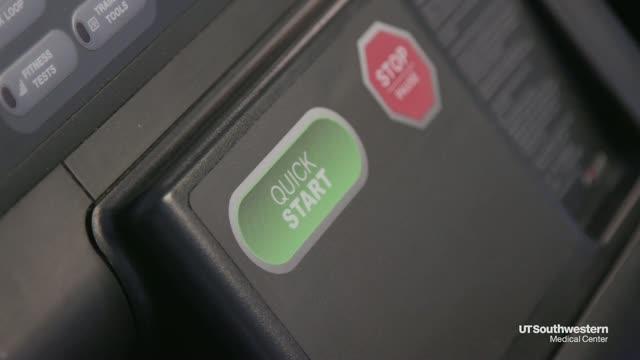
VIDEO: Experts from UT Southwestern have found that, contrary to early concerns, endurance exercise has many positive effects on heart health. view more
DALLAS – Jan. 30, 2019 – Exercise is often cited as the best preventive medicine, but how much is too much for the hearts of middle-aged athletes?
Watch video: Running to extremes: High-endurance exercise OK for heart health
Sports cardiologist Dr. Benjamin Levine led a study, now published in JAMA Cardiology, to find the answer. Dr. Levine is a Professor of Internal Medicine and Director of the Institute for Exercise and Environmental Medicine, a collaboration between UT Southwestern Medical Center and Texas Health Presbyterian Hospital Dallas.
What is coronary calcium scanning and why is it important?
Coronary calcium scanning is an imaging test that helps physicians classify patients without cardiac symptoms as low, intermediate, or high risk for heart attack. It represents how much calcium (and thus cholesterol deposits) has accumulated in the blood vessels that supply the heart. The scan can help physicians determine the need for medication, lifestyle modification, and other risk-reducing measures. Learn more
“The question has never been whether exercise is good for you, but whether extreme exercise is bad for you. For the past decade or so, there’s been increasing concern that high-volume, high-intensity exercise could injure the heart. We found that high volumes of exercise are safe, even when coronary calcium levels are high,” Dr. Levine said.
High-volume, high-intensity exercise was defined in this study as at least five to six hours per week at a pace of 10 minutes per mile. The average amount of high-intensity exercise in this group was eight hours per week.
Coronary calcium is a footprint of atherosclerosis, a disease in which plaque builds up in the arteries and gives rise to heart attack and stroke. When coronary calcium is detected in the heart, the clogging process within the blood vessels has begun. The majority of high-intensity athletes had low levels of coronary calcium, though their odds of having higher levels were 11 percent greater than men who exercised less. Most importantly, the researchers found that higher calcium scores did not raise the high-intensity athletes’ risk for cardiovascular or all-cause mortality.
Dr. Levine studied data from the Cooper Center Longitudinal Study. A total of 21,758 generally healthy men ages 40 to 80 and without cardiovascular disease were followed for mortality between 1998 and 2013. The athletes, a majority of them in middle age, reported their physical activity levels and underwent coronary calcium scanning. Most were predominantly runners, but some were cyclists, swimmers, or rowers. A subgroup of athletes trained in three of these sports.
Women were not included in the study as their mortality rates are lower than for men.
Despite the findings that extreme exercise does not raise heart disease risk, Dr. Levine advises against using the protective effect of exercise to excuse poor lifestyle habits. “You cannot overcome a lifetime of bad behaviors – smoking, high cholesterol, hypertension – just from doing high levels of physical activity, so don’t use that as a magical cure,” said Dr. Levine, who holds the Distinguished Professorship in Exercise Sciences at UT Southwestern.
He also recommends caution when starting a new training program. “If you want to train for a marathon, you have to have a long-range plan to build up slowly before you achieve those volumes and intensity of exercise.”
“The known benefits of regular physical activity in the general population include decreased mortality, heart disease, diabetes, and many other medical conditions which reminds us how important it is participate in regular physical activity as recommended by the 2018 Physical Activity Guidelines,” said Dr. Laura DeFina, Chief Scientific Officer of The Cooper Institute and co-author of the study. “The current study shows no increased risk of mortality in high-volume exercisers who have coronary artery calcium. Certainly, these high-volume exercisers should review their cardiovascular disease risk with their primary care doctor or cardiologists and the study results provide helpful clinical guidance.”
“The most important take-home message for the exercising public is that high volumes of exercise are safe. The benefits of exercise far outweigh the minor risk of having a little more coronary calcium,” Dr. Levine said.
###
Other UT Southwestern researchers who contributed to this work include Dr. Jarett D. Berry, Associate Professor of Internal Medicine and Clinical Sciences, and Dr. Amit Khera, Professor of Internal Medicine and Director of the Preventive Cardiology Program. Dr. Khera holds the Dallas Heart Ball Chair in Hypertension and Heart Disease. Dr. Berry is a Dedman Family Scholar in Clinical Care.
About UT Southwestern Medical Center
UT Southwestern, one of the premier academic medical centers in the nation, integrates pioneering biomedical research with exceptional clinical care and education. The institution’s faculty has received six Nobel Prizes, and includes 22 members of the National Academy of Sciences, 17 members of the National Academy of Medicine, and 15 Howard Hughes Medical Institute Investigators. The faculty of more than 2,700 is responsible for groundbreaking medical advances and is committed to translating science-driven research quickly to new clinical treatments. UT Southwestern physicians provide care in about 80 specialties to more than 105,000 hospitalized patients, nearly 370,000 emergency room cases, and oversee approximately 2.4 million outpatient visits a year.
Disclaimer: AAAS and EurekAlert! are not responsible for the accuracy of news releases posted to EurekAlert! by contributing institutions or for the use of any information through the EurekAlert system.

